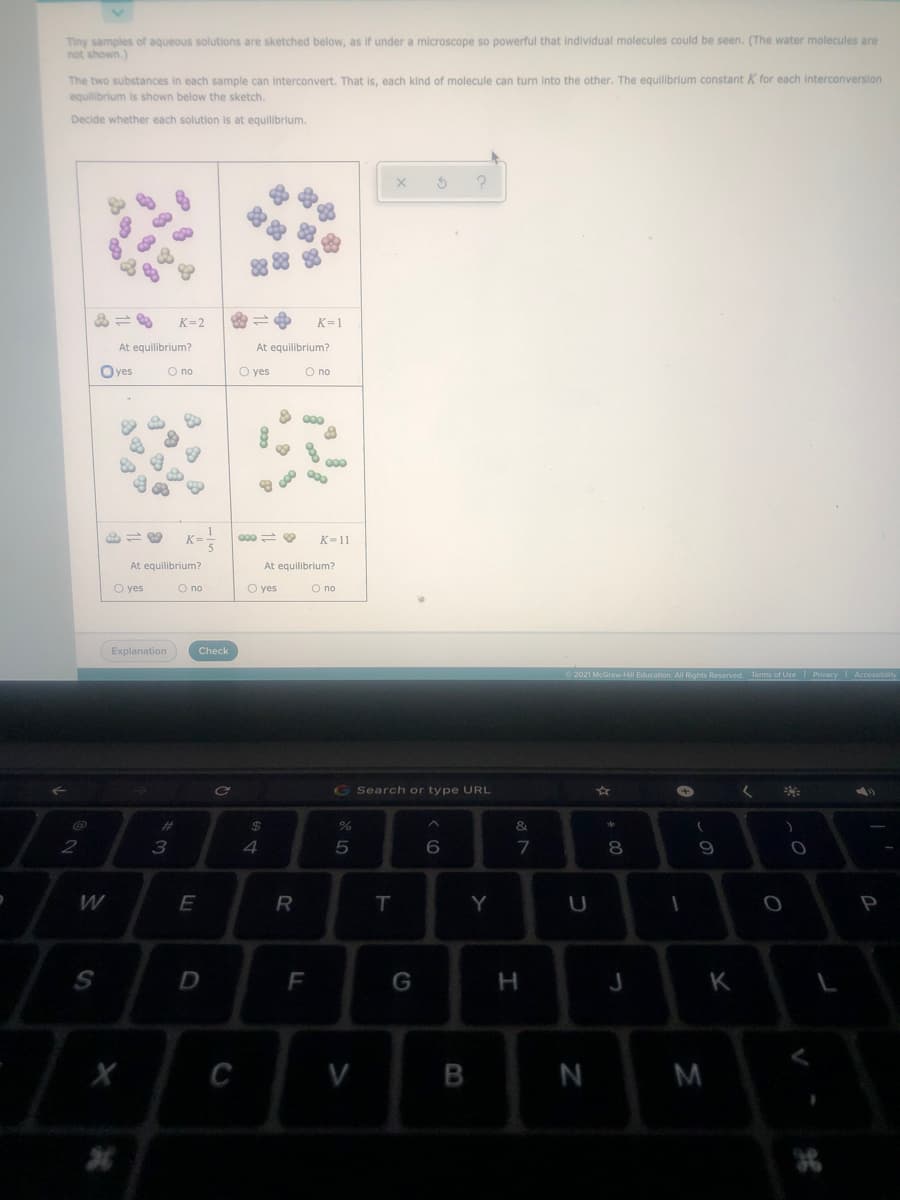Tiny samples of aqueous solutions are sketched below, as if under a microscope so powerful that individual molecules could be seen. (The water molecules are not shown.) The two substances in each sample can interconvert. That is, each kind of molecule can turn into the other. The equilibrium constant K for each interconversion equilibrium is shown below the sketch. Decide whether each solution is at equilibrium. & 88 K=1 K=2 At equilibrium? At equilibrium? Oyes O no O yes O no K=11 At equilibrium? At equilibrium? O yes O no O yes O no 1L *
Tiny samples of aqueous solutions are sketched below, as if under a microscope so powerful that individual molecules could be seen. (The water molecules are not shown.) The two substances in each sample can interconvert. That is, each kind of molecule can turn into the other. The equilibrium constant K for each interconversion equilibrium is shown below the sketch. Decide whether each solution is at equilibrium. & 88 K=1 K=2 At equilibrium? At equilibrium? Oyes O no O yes O no K=11 At equilibrium? At equilibrium? O yes O no O yes O no 1L *
Chemistry: An Atoms First Approach
2nd Edition
ISBN:9781305079243
Author:Steven S. Zumdahl, Susan A. Zumdahl
Publisher:Steven S. Zumdahl, Susan A. Zumdahl
Chapter12: Chemical Equilibrium
Section: Chapter Questions
Problem 2RQ: What is the law of mass action? Is it true that the value of K depends on the amounts of reactants...
Related questions
Question

Transcribed Image Text:Tiny samples of aqueous solutions are sketched below, as if under a microscope so powerful that individual molecules could be seen. (The water molecules are
not shown.)
The two substances in each sample can interconvert. That is, each kind of molecule can turn into the other. The equillbrium constant K for each interconversion
equilibrium is shown below the sketch.
Decide whether each solution is at equilibrium.
K=2
K=1
At equilibrium?
At equilibrium?
O yes
O no
O yes
O no
8 00
0002
5
K=11
At equilibrium?
At equilibrium?
O yes
O no
O yes
O no
Explanation
Check
G Search or type URL
%2#3
&
3
4
7
8.
W
E
R
T.
Y
P
F
G
H
V
N
M
Expert Solution
This question has been solved!
Explore an expertly crafted, step-by-step solution for a thorough understanding of key concepts.
This is a popular solution!
Trending now
This is a popular solution!
Step by step
Solved in 2 steps with 2 images

Knowledge Booster
Learn more about
Need a deep-dive on the concept behind this application? Look no further. Learn more about this topic, chemistry and related others by exploring similar questions and additional content below.Recommended textbooks for you

Chemistry: An Atoms First Approach
Chemistry
ISBN:
9781305079243
Author:
Steven S. Zumdahl, Susan A. Zumdahl
Publisher:
Cengage Learning


Chemistry
Chemistry
ISBN:
9781305957404
Author:
Steven S. Zumdahl, Susan A. Zumdahl, Donald J. DeCoste
Publisher:
Cengage Learning

Chemistry: An Atoms First Approach
Chemistry
ISBN:
9781305079243
Author:
Steven S. Zumdahl, Susan A. Zumdahl
Publisher:
Cengage Learning


Chemistry
Chemistry
ISBN:
9781305957404
Author:
Steven S. Zumdahl, Susan A. Zumdahl, Donald J. DeCoste
Publisher:
Cengage Learning

Chemistry: The Molecular Science
Chemistry
ISBN:
9781285199047
Author:
John W. Moore, Conrad L. Stanitski
Publisher:
Cengage Learning

Chemistry for Engineering Students
Chemistry
ISBN:
9781337398909
Author:
Lawrence S. Brown, Tom Holme
Publisher:
Cengage Learning

Introductory Chemistry: A Foundation
Chemistry
ISBN:
9781285199030
Author:
Steven S. Zumdahl, Donald J. DeCoste
Publisher:
Cengage Learning